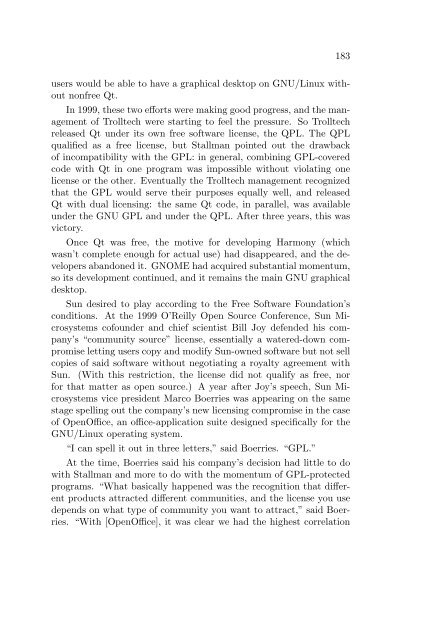Create successful ePaper yourself
Turn your PDF publications into a flip-book with our unique Google optimized e-Paper software.
183<br />
users would be able to have a graphical desktop on GNU/Linux without<br />
nonfree Qt.<br />
In 1999, these two efforts were making good progress, and the management<br />
of Trolltech were starting to feel the pressure. So Trolltech<br />
released Qt under its own free software license, the QPL. The QPL<br />
qualified as a free license, but Stallman pointed out the drawback<br />
of incompatibility with the GPL: in general, combining GPL-covered<br />
code with Qt in one program was impossible without violating one<br />
license or the other. Eventually the Trolltech management recognized<br />
that the GPL would serve their purposes equally well, and released<br />
Qt with dual licensing: the same Qt code, in parallel, was available<br />
under the GNU GPL and under the QPL. After three years, this was<br />
victory.<br />
Once Qt was free, the motive for developing Harmony (which<br />
wasn’t complete enough for actual use) had disappeared, and the developers<br />
abandoned it. GNOME had acquired substantial momentum,<br />
so its development continued, and it remains the main GNU graphical<br />
desktop.<br />
Sun desired to play according to the Free Software Foundation’s<br />
conditions. At the 1999 O’Reilly Open Source Conference, Sun Microsystems<br />
cofounder and chief scientist Bill Joy defended his company’s<br />
“community source” license, essentially a watered-down compromise<br />
letting users copy and modify Sun-owned software but not sell<br />
copies of said software without negotiating a royalty agreement with<br />
Sun. (With this restriction, the license did not qualify as free, nor<br />
for that matter as open source.) A year after Joy’s speech, Sun Microsystems<br />
vice president Marco Boerries was appearing on the same<br />
stage spelling out the company’s new licensing compromise in the case<br />
of OpenOffice, an office-application suite designed specifically for the<br />
GNU/Linux operating system.<br />
“I can spell it out in three letters,” said Boerries. “GPL.”<br />
At the time, Boerries said his company’s decision had little to do<br />
with Stallman and more to do with the momentum of GPL-protected<br />
programs. “What basically happened was the recognition that different<br />
products attracted different communities, and the license you use<br />
depends on what type of community you want to attract,” said Boerries.<br />
“With [OpenOffice], it was clear we had the highest correlation


